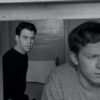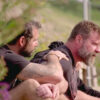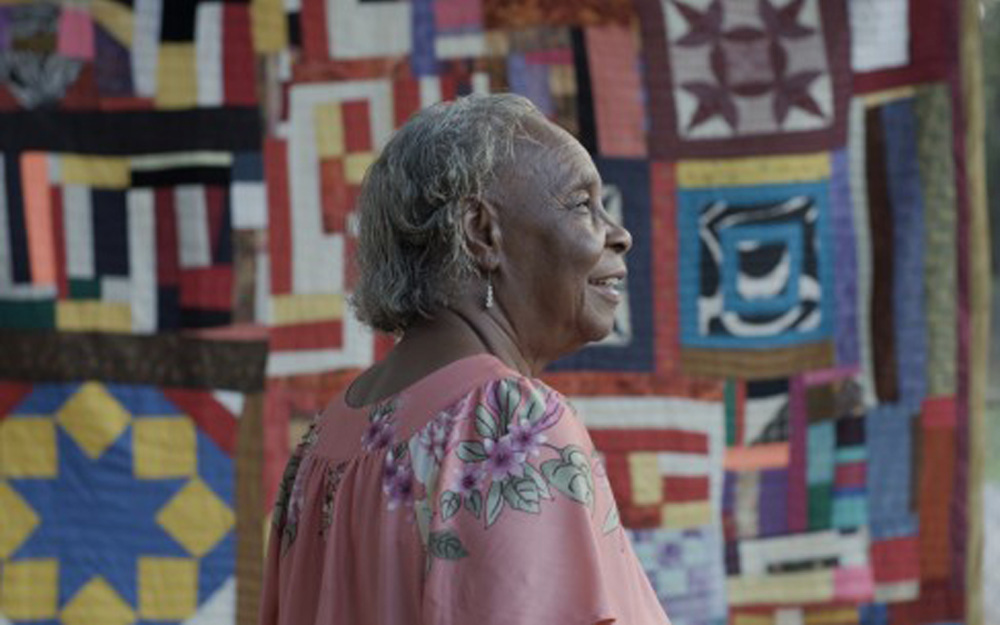It isn’t uncommon for the women of Gee’s Bend, Alabama to spontaneously break out into song. Surrounded by the Alabama River, they live at a remove from the world at large, treading the same soil that their ancestors did as slaves and cultivating a rich culture of their own in the time since. Spirituals that have been passed along from one generation to another at home or in the church travel as freely in their air as they do by blood and while the community often eludes the spotlight, their tradition for quilt making, where every stitch is filled with strands of history, has not gone unnoticed, attracting the attention of some of the most prestigious museums around the world as well as the filmmaker Maris Curran.
“The title of the film comes from that first song [you hear, “I Don’t Want No One to Praise Me When I’m Gone”], which is about not getting recognition while you’re alive and getting wasted on the dead, which I think is appropriate,” said Curran of “While I yet Live,” a proper celebration of these remarkable women that recently premiered at Berlinale and will play this weekend at the Aspen Shortsfest and the San Francisco Film Festival.
Taking audiences into the artists’ enclave with the same sensitivity she brought to bear on her narrative feature debut, the compassionate David Oyelowo drama “Five Nights in Maine,” Curran gracefully profiles Essie Pettway and her mother Mary Lee Bendolph, as well as their knitting circle that includes Rita Mae Pettway, Lucy Mingo, China Pettway and Mary Ann Pettway, whose personal histories extend back to before the civil rights movement and can be seen providing the foundation for future generations through their unbreakable bond. Just as the quilters use their tapestries to portray a diversity of experience, Curran blends the sights and sounds of Gee’s Bend to give a vivid sense of how special a place it is while allowing the quiet strength of the women to emerge from the poise and dignity with which they carry themselves every day, as well as how boldly they express themselves in their work.
Although the women of Gee’s Bend are all too conscious that they don’t live in a bubble, “While I yet Live” offers a respite for everyone else in the privilege to spend time with a collective that so ably realizes the artistic possibilities within their own lives. The beautiful portrait of these artists joins Curran’s previous mini-doc “The Man is the Music,” which can be seen here about the multimedia mastermind Lonnie Holley, as a true work of art unto itself and recently Curran spoke about how the films are connected, as well as how the bewitching style of “While I yet Live” was informed by its subject matter and the experience of filming shortly before the 2016 presidential election.
How’d you venture to the South?
If you remember “Five Nights” begins in Atlanta and makes this migration north. I wanted the film to end with sounds of the south and so I got in touch with the musician Lonnie Holley — I wanted his voice to be the last thing you heard in the film. He produced a song for “Five Nights” and through the process of collaborating, we decided to work on a documentary together. I made “The Man is The Music” about his source of inspiration and when he saw the film, he said, “I have to take you somewhere” — and that place was Gee’s Bend, AL. I had known about the Gee’s Bend Quilters because their work had been exhibited at several museums, including at the Whitney Museum of Art and the Houston Museum of Fine Arts. I had always been struck by their work, but when researching more about the work, found that the women’s voices were absent.
When we went to Gee’s Bend with Lonnie for the first time, it was incredible. It’s the most rural place I’ve been in this country. It’s about an hour south of Selma, and the place has a very specific and important history. It’s a very small community. You have no cell phone service when you’re there, and we were welcomed unbelievably warmly into these women’s homes. One of the most famous quilters [there] who’s still alive is Mary Lee Bendolph. Her quilts are featured prominently in the film. She and her daughter, Essie Pettway are at the center of the film.
In our correspondence setting this up, it sounded like you were looking to make something like this – capturing women in their space, as you mentioned. Is that the case?
That in a lot of ways is what drove the piece, really wanting to know what these women wanted to say [and] asking what is important in their lives, what are they worried about, what brings them joy. I’m interested in how you access the truth of our lives. If you tell a story and tell it specifically, it has the potential to move a person and possibly lead us to a greater understanding of the human experience.
How’d you hook up with cinematographer Jerry Henry, who shot both of these?
Jerry and I live in the same neighborhood about a mile away from each other, and we actually were introduced by [“Nancy” director] Christina Choe, who is a dear friend of mine. Another cinematographer that I love was meant to shoot “The Man is the Music” and because another production went [into filming] faster than he anticipated, he ended up not being able to shoot. I had this shoot all lined up and I needed someone pretty quickly. Jerry and I had our first meeting at the local mechanic because he had to get his car serviced. I brought these oversized monographs with images of quilts and storyboards. We jumped right in and we had an incredible shoot [on “The Man is the Music”] and we’re at a point now where we’ve worked together enough where we only need so much language while we’re actually shooting. He’s incredibly talented. I trust him thoroughly and I think we make each other better as filmmakers.
How many times did you visit Gee’s Bend?
We went three times to shoot, but the beginning, of course, is more of a dance. You’re getting to know people and you’re building trust. I always try to spend as much time with people before you do an actual interview so as possible. I am always curious to hear what is on someone’s mind.
I knew quite a bit about the history of this place and what these quilts looked like, and how they’d been positioned in the world, but what I didn’t know is what did these women’s lives look like and how in lives that were filled with a huge amount of work and raising and caring for their families did they make time to make these extraordinary pieces of art? I was also really curious about how their lives had changed since their work made it out into the world and how their sense of self had changed too. That’s what lead me. I wanted to ask: “What about this is important to you? What is most important for you today?”
I went in thinking that the film is about making art in everyday life, inspiration and kinship, but ultimately, I think the film is all about love — love of family, love of God and also love of self.
Do you approach a short differently after making a feature?
When you’re working on a film for, let’s say, three to five years, it takes so much. You work on the project constantly, but there’s nothing immediate about working on a project that takes that long. So there’s been something very liberating about working in short form where you set out to make something and can realize it in a short period of time. It allows for a different level of urgency to it. For example, we were interviewing Ms. Mingo, who talks in the film about fighting to register to voter during the Civil Rights [movement]. This area [of Gee’s Bend] was very important in voting rights and [this interview] was the Sunday before the 2016 election, so she was talking about what her morning was going to look like on that Tuesday, and she was determined to be the first person in line to vote.
To some degree, the film makes Gee’s Bend feel like this wonderful cocoon, but you do see the concerns of the larger world make their way in like the “Wilcox Lives Matters” shirt Rita Mae’s granddaughter wears or a plate commemorating Obama out on display. How conscious were you of those allusions?
We just tried to be really honest and show what the place feels like. The film is not about nostalgia. It’s about women passing on tradition. There are young people in this community, but there are not many jobs, so young folks often have to leave for work. You see young men riding by on horseback and Rita Mae teaching her granddaughter to quilt in the film. It’s essential that a piece like this references history, especially because some of the women in the film are older and historically, this region is very important in terms of the Civil Rights movement in the country, and still is. In the beginning of the film, you see the Edmund Pettus Bridge, which is about 55 miles north of [Gee’s Bend] and was the site of Bloody Sunday — where voting rights demonstrators were attacked violently by law enforcement in 1965.
There is this mosaic-like quality to how the film unfolds aesthetically. Was that inspired by the subject?
I was interested in putting the film together almost like a quilt, so I think that’s what you’re feeling. One fascinating aspect of being in this area is that the quilts take inspiration from their surroundings. You look at the quilts and then you look at the surroundings and you see this dialogue happening between place, between architecture and the landscape, and the work that these women are making. We wanted to show that and create this enveloping world for this part of Alabama.
There are [also] a lot of senses that get triggered when you move away from busy commercial centers, so when you’re somewhere that’s very rural, sound shifts and shows you how far away from it all you really are. So sound [became] really important for the film. I work with the sound designer Eli Cohn on my films. I love working with him.
Our crew on the film was small. It was my DP, Jerry Henry our amazing producer Jon Coplon, and me. I have an incredible editor Julie Caskey, who is in San Francisco, and she cut “The Man is the Music” too. We’re all working on a feature doc now.
What’s that about?
We’re midway in production and it’s about a woman who survived the massacre at the Pulse Nightclub. She’s a competitive bodybuilder and a mother. She lives in Orlando, but is originally from Puerto Rico and when Hurricane Maria hit, it felt to her like Pulse happening all over again. The film is about the ways she’s been able to transform her grief into positivity for herself and her community. She’s an inspiring and complicated woman.
What’s it like to travel with “While I yet Live?” Did you accompany the film at its Berlinale premiere?
Yes! It was amazing. There’s an avid audience for short films at the Berlin International Film Festival, which I’ve never experienced before, so we had sold out screenings and the film played well. The [short] programs were great. It was fun to see the other talented filmmakers’ work and we also were able to show the film at MoMA’s Doc Fortnight. And we’ve showed [the women] a fine cut of the film, but they haven’t seen the finished film. I’m trying to set up a screening when the weather’s nice so we can have a party in Gee’s Bend and show it. I can’t wait.
“While I yet Live” will next play at the Aspen Shortsfest on April 6th at 5:15 pm at the Wheeler Opera House, the San Francisco Film Festival as part of Shorts Program 1 on April 7th at 2 pm and April 11th at 4 pm at the Roxie Theater, and the Ashland Film Festival on April 12th and 13th at 3:30 pm at the Varsity Theater 5.




